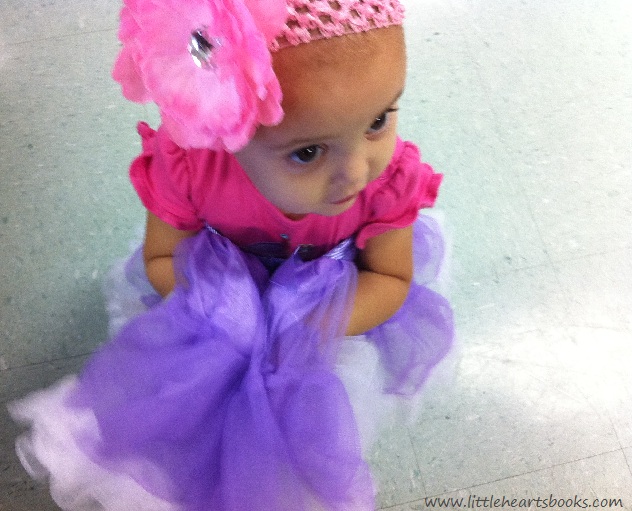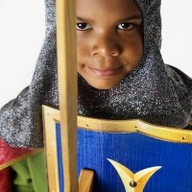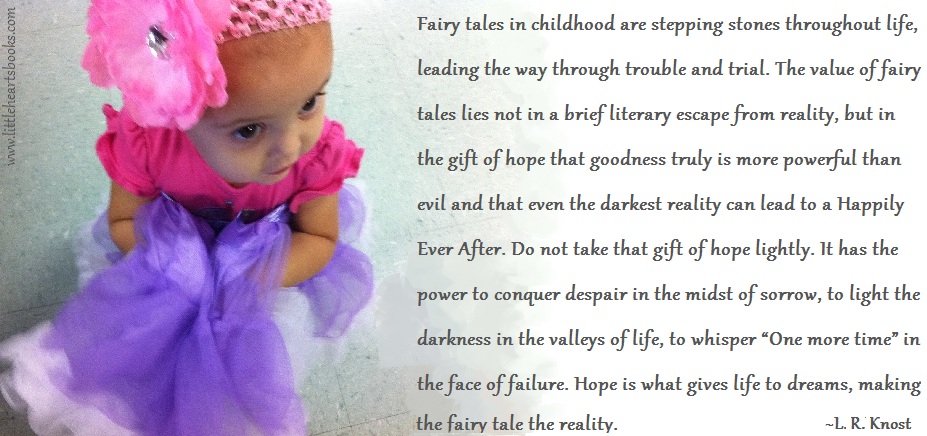Fairy Tales~The Lost Treasure of ‘Once upon a time…’
[Portions reprinted with permission from Raising Bookworms: Tips, Tools & Techniques for Sharing a Love of Reading with Children by L.R.Knost available June 2014; Two Thousand Kisses a Day: Gentle Parenting Through the Ages and Stages by L.R.Knost now available.]
~~~~~~~
Fairy tales do not tell children that dragons exist. Children already know that dragons exist. Fairy tales tell children the dragons can be beaten.
~ G. K. Chesterton
 Fairy tales and folklore, those purveyors of ancient truths passed from one generation to the next, first through oral tradition, then in gloriously illustrated text, have fallen out of favor off and on throughout the centuries. They’ve been deemed outlandish, scandalous, frivolous, sexist, childish, etc. depending on what culture or era is doing the labeling at the time.
Fairy tales and folklore, those purveyors of ancient truths passed from one generation to the next, first through oral tradition, then in gloriously illustrated text, have fallen out of favor off and on throughout the centuries. They’ve been deemed outlandish, scandalous, frivolous, sexist, childish, etc. depending on what culture or era is doing the labeling at the time.
The tragedy and travesty of such labeling is found in the loss of imagery, creativity, wonder, and awe engendered by the retelling of the “Once upon a time…” tales of old. It is found in the generations who missed the life lessons woven into the colorful tapestry of timeless storytelling and who were never gifted with the wealth of beauty, richness, and depth to be found in hearing and reading the wisdom of past generations in the artistry of the wordsmith.
There is not only great literary value to fairy tales, but great life value as well. In a literary sense, fairy tales are an excellent tool for teaching characterization, plot, setting, mood, tone, style, and more. Fairy tales are also excellent teaching tools for reading because they hold children’s attention through mesmerizing plot twists, exciting action scenes, and heart-pounding drama. But beyond the literary lessons lie deep life lessons of good triumphing over evil, of kindness winning in the face of cruelty, of hope kept alive in the depths of despair, of transformation, love, and second chances.
In the classic tale of Cinderella, a young woman shows her strength of character by clinging to hope and goodness and kindness in the face of terrible loss and inhumane treatment. She returns kindness for selfishness at the hands of her stepsisters and humility for cruelty at the hands of her stepmother. And through it all, her inner beauty blossoms like a wildflower breaking through a rocky, inhospitable terrain. The reward for her goodness takes the form of a fairy godmother, a prince charming, and her very own Happily Ever After. Life lesson~Good truly does have the power to triumph over evil.
In Snow White, a young princess is mistreated and cast out by a wicked queen who wants not only the throne, but the vain prestige of singular beauty for herself. In the face of this harsh reality, Snow White befriends a band of misfits and, with a gentleness and joy that wins even the grumpiest heart, sets out to make the best of her harsh circumstances, showing a strength of character that we would all do well to emulate. Her persistence and goodness are rewarded with the loyalty and friendship of her goodhearted band of misfits and a new life and love in her own Happily Ever After. Life lesson~Kindness can, indeed, overcome cruelty.
In The Elves and the Shoemaker, a hardworking man of strength and character stays the course, day after day, clinging to hope and choosing honesty, goodness, and humility over profit. In the face of mounting despair and imminent loss, his persistence and goodness are rewarded with the help of some busy little friends who save his home and shop and elevate his artistry to the level of greatness, leading to his own Happily Ever After. Life lesson~Hope is the path out of despair.
In Beauty and the Beast, a young prince allows his pride and selfishness to lead him into a dark, enchanted world of trouble and despair. But over time love and friendship nurture the seeds of goodness in his heart and begin to transform him, and his inner transformation is rewarded with the love of the intelligent and daring Beauty who rescues him from the cruelty of the world, and with an outer transformation back into a man with a second chance at life, ending in his own Happily Ever After. Life lesson~Love has the power to change the hardest of hearts.
Albert Einstein said, “If you want your children to be intelligent, read them fairy tales. If you want them to be more intelligent, read them more fairy tales.”
According to Hans Christian Anderson, “Life itself is the most wonderful fairytale of all.” And two time Nobel  Prize recipient, physicist, and chemist, Marie Curie believed that, “A scientist in his laboratory is not a mere technician: he is also a child confronting natural phenomena that impress him as though they were fairy tales.”
Prize recipient, physicist, and chemist, Marie Curie believed that, “A scientist in his laboratory is not a mere technician: he is also a child confronting natural phenomena that impress him as though they were fairy tales.”
American novelist, R.A. Salvatore said, “No, I would not want to live in a world without dragons, as I would not want to live in a world without magic, for that is a world without mystery, and that is a world without faith.”
And, from one of my all-time favorite authors, C.S.Lewis, “When I was ten, I read fairy tales in secret and would have been ashamed if I had been found doing so. Now that I am fifty, I read them openly. When I became a man, I put away childish things, including the fear of childishness and the desire to be very grown up.”
All of these learned and creative minds had the same view of fairy tales: They are valuable beyond the momentary entertainment and for more than their literary worth.
Fairy tales in childhood are stepping stones throughout life, leading the way through trouble and trial. The value of fairy tales lies not in a brief literary escape from reality, but in the gift of hope that goodness truly is more powerful than evil and that even the darkest reality can lead to a Happily Ever After. Do not take that gift of hope lightly. It has the power to conquer despair in the midst of sorrow, to light the darkness in the valleys of life, to whisper “One more time” in the face of failure. Hope is what gives life to dreams, making the fairy tale the reality.
“Do not meddle in the affairs of dragons, for you are crunchy and taste good with ketchup.”
~ Scott Adams (American author and cartoonist)
Related posts:
In the world of a child wonders are as simple as sticks and sheets, leaves and books, boxes and giggles, and the promise in a rainy day. The Seven Wonders of the World of Childhood
Woven through every event, every tradition, every memorable moment of our family’s Christmas, is the celebration of the wondrous gift of a Savior. We watch Rudolph the Red-Nosed Reindeer, Santa Claus is Coming to Town, and all the other fun Christmas shows together. We read bedtime stories about Christmas elves and Magical toys and talking animals. And when my children ask me if Santa really exists, I tell them yes, because it’s true. Every parent who carries on St. Nicholas’ tradition of leaving secret gifts, of being the heart and hands of Jesus, of sharing the wonder, excitement, and glory of the most extraordinary Gift ever given to mankind, every one of us is Santa Claus. The Great Santa Claus Debate
There is such a rush these days to get children sleeping through the night, weaned off the breast, eating solid foods, potty trained, reading independently, and on and on, that we seem to have lost the ability to simply enjoy life as it happens and let our children do the same. A Return to Childhood
On a Winnie the Pooh style ‘long explore’ my little Pooh Bear discovered the world in ways only a toddler can in…The Many Adventures of My Little Pooh Bear
Children who love to read…READ! Engaging children’s hearts in the wonder of reading instead of just training their minds in its mechanics. Raising Bookworms
Successful reading means far more than possessing the ability to read. Engaging the hearts of students moves reading success beyond a life skill and turns it into a life style. And graphic novels are too powerful of a tool in our arsenal to be disregarded because of pride or prejudice. Raising Super Readers~The MARVELous Power of Comic Books!
Parenting choices strongly impact the level and type of attachment a child develops and, by extension, the development of a love of learning. A love of learning grows when it isn’t stifled by fear or stress or regimented by over-structuring or a focus on achievement or competition. Parents fostering a healthy attachment are thus also fostering a life-long love of learning in their children. Love, Play, Learn!
The human brain needs time to process, catagorize, prioritize, analyze, and otherwise make sense of all of the trillions of bits of information that it recieves each day. Non-structured playtime for children functions much like sleep does for adults, giving their brains the time and space they need to move short-term memory to long term learning. 25 Reasons NOT to Keep Children Busy

 Award-winnning author, L.R.Knost, is the founder and director of the children's rights advocacy and family consulting group, Little Hearts/Gentle Parenting Resources, and Editor-in-Chief of Holistic Parenting Magazine. Books by L.R.Knost include Whispers Through Time: Communication Through the Ages and Stages of Childhood ; Two Thousand Kisses a Day: Gentle Parenting Through the Ages and Stages ; The Gentle Parent: Positive, Practical, Effective Discipline ; and Jesus, the Gentle Parent: Gentle Christian Parenting the first four books in the Little Hearts Handbook gentle parenting series, and children’s picture books Petey’s Listening Ears and the soon-to-be-released Grumpykins series.
Award-winnning author, L.R.Knost, is the founder and director of the children's rights advocacy and family consulting group, Little Hearts/Gentle Parenting Resources, and Editor-in-Chief of Holistic Parenting Magazine. Books by L.R.Knost include Whispers Through Time: Communication Through the Ages and Stages of Childhood ; Two Thousand Kisses a Day: Gentle Parenting Through the Ages and Stages ; The Gentle Parent: Positive, Practical, Effective Discipline ; and Jesus, the Gentle Parent: Gentle Christian Parenting the first four books in the Little Hearts Handbook gentle parenting series, and children’s picture books Petey’s Listening Ears and the soon-to-be-released Grumpykins series.








